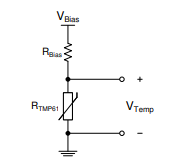Hello E2E Experts,
Good day.
I am using the TMP6131QDYATQ1 PTC Thermistor on a new design and the part's datasheet instructs the user to download the Thermistor Design Tool to obtain Steinhart-Hart parameters, look up tables, etc.
However, I am not able to enter data such as Vbias, Rbias, and ADC resolution into the worksheet cells because the cells are protected and to unprotect the cells requires a password.
I saw this E2E link that explains why certain parameters are locked on the Excel sheet and I understood the explanation regarding the thermistor design tool.


